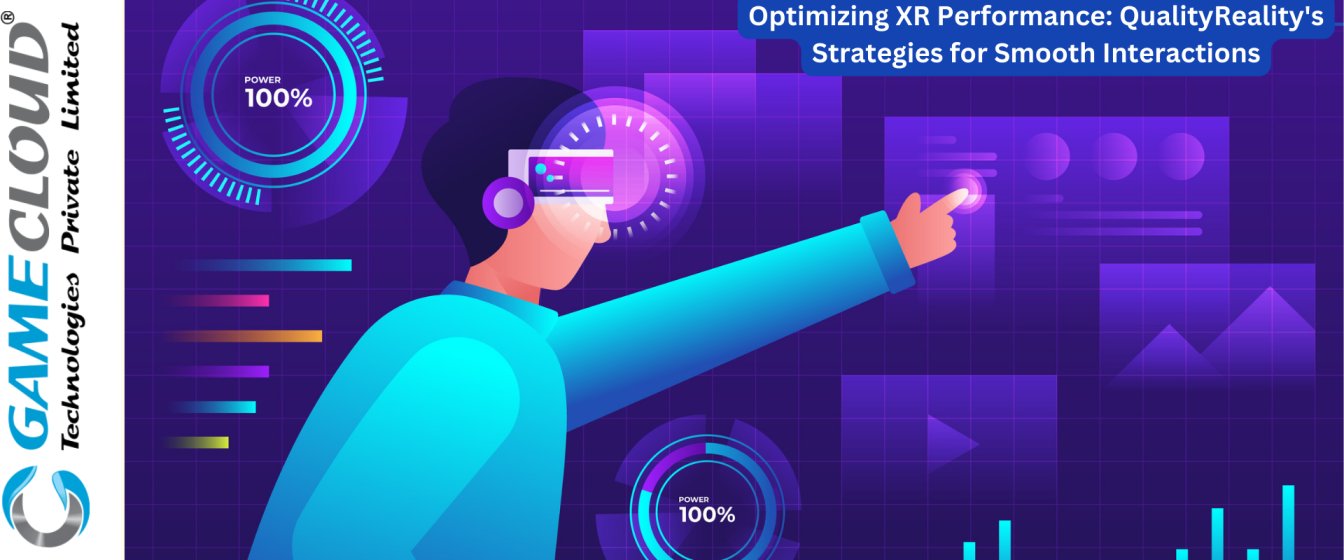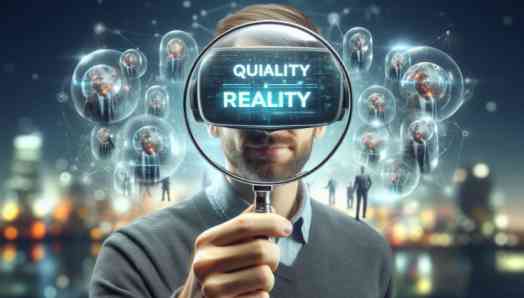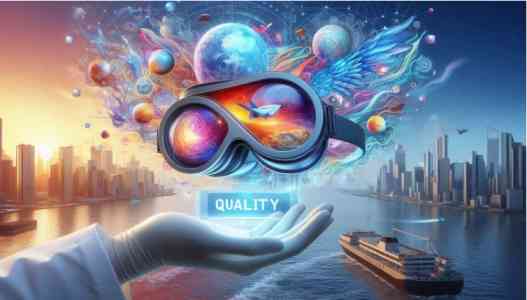
Extended Reality (XR) has revolutionized the gaming industry by providing immersive experiences that blur the lines between the physical and digital worlds. However, the complexity of XR environments can lead to performance issues, disrupting the seamless interactions that are crucial for an engaging gaming experience. In this blog, we will delve into the strategies for optimizing XR performance, focusing on game development and exploring the current landscape, futuristic trends, and predictions.
Understanding the Basics of XR Performance
Before diving into optimization techniques, it’s essential to grasp the core concepts that underpin XR performance. At the heart of XR is the need for real-time rendering, which demands both the Central Processing Unit (CPU) and Graphics Processing Unit (GPU) to work in harmony. The CPU processes game logic and physics, while the GPU handles rendering of the 3D environment. Achieving a high frame rate and low latency is paramount for preventing motion sickness and maintaining immersion.
- Profiling and Benchmarking
The first step in optimization is profiling and benchmarking. Tools like Unity’s Profiler and Unreal Engine’s Performance and Profiling tools allow developers to measure frame rate, rendering times, and other critical performance metrics. By identifying bottlenecks, developers can make informed decisions on where to focus their optimization efforts.
- Asset Optimization
Optimizing 3D models, textures, and animations is vital for XR performance. Techniques such as Level of Detail (LOD) models, occlusion culling, and efficient use of texture atlases can significantly reduce the rendering load. Additionally, developers should be mindful of the polygon count and texture resolutions to ensure assets are not overly taxing on the system.
- Code Optimization
Writing efficient code is just as important as asset optimization. This includes minimizing draw calls, batching similar operations, and reducing the complexity of shaders. Developers should also leverage data-oriented design and entity-component systems to streamline game logic and physics calculations.
- Rendering Techniques
XR applications can benefit from specialized rendering techniques like foveated rendering, which reduces the rendering quality in the peripheral vision to focus processing power where the user is looking. Single Pass Stereo rendering can also improve performance by rendering both eye views in a single pass.

The Current Landscape and Trends
The current XR landscape is witnessing rapid advancements in hardware and software. With the release of devices like the Oculus Quest 2 and Valve Index, standalone and PC-tethered experiences are becoming more accessible. On the software front, game engines are continuously evolving, with Unity and Unreal Engine leading the charge in providing robust tools for XR development. The current landscape is also characterized by the increasing adoption of cloud-based and edge computing technologies to overcome the limitations of traditional cloud-based XR environments. For instance, a recent study proposed a novel XR system that leverages edge and fog computing to enhance the performance of XR environments. This approach has shown significant improvements in terms of latency and overall user experience.
Let’s dive deeper into the trends shaping the future of Extended Reality (XR) in game development. These trends promise to redefine immersive experiences and revolutionize how we interact with digital environments:
- Artificial Intelligence (AI) and Machine Learning
Generative AI and machine learning are becoming integral to XR experiences. In the realm of game development, these technologies enhance realism, interactivity, and personalization. Imagine dynamically creating environments, characters, and narratives that respond intelligently to user actions. The fusion of generative AI and XR opens up unprecedented possibilities for creating dynamic, ever-evolving virtual worlds that adapt to the player’s choices and actions.
- Metaverse XR Trend
The concept of the Metaverse is no longer confined to science fiction; it’s becoming a reality. In 2024, the Metaverse XR trend is set to explode, creating interconnected virtual spaces where users can seamlessly navigate between different XR experiences. From gaming realms to social interactions, the Metaverse will break conventional boundaries, providing users with a dynamic and interconnected digital universe.
- Mixed-Reality XR Ecosystems
XR ecosystems are evolving to become more interconnected and user-friendly. Seamless transitions between augmented reality (AR) and virtual reality (VR) experiences, cross-platform compatibility, and collaborative XR environments are defining the future of XR ecosystems. Developers are working on creating cohesive experiences that seamlessly blend digital and physical elements, allowing users to interact in real-time across different devices and platforms.
- Immersive Experiences Beyond Gaming
While gaming has been a trailblazer for XR, its impact extends far beyond entertainment. Educational institutions leverage immersive simulations for hands-on learning experiences, allowing students to explore historical events or conduct virtual experiments. Healthcare professionals utilize XR for realistic medical training, enhancing skills and improving patient care. Additionally, XR applications for mental health are gaining prominence, providing immersive environments for stress relief, anxiety management, and psychological well-being.
- Mainstream Adoption
As XR technology matures, it’s gradually becoming more accessible to the masses. Increased affordability, improved hardware, and a growing library of XR content contribute to its mainstream adoption. Expect to see XR experiences integrated into everyday life, from education and healthcare to business and entertainment.
- Multi-Sensory Tech
Developers are exploring ways to engage multiple senses simultaneously. Haptic feedback, spatial audio, and even smell-based interactions enhance immersion. Imagine feeling the texture of a virtual object or hearing footsteps behind you in an XR environment. Multi-sensory tech will play a pivotal role in creating truly immersive experiences.
- Wearables Integration
Wearable devices, such as smart glasses and haptic suits, will play a significant role in XR adoption. These devices enhance immersion by providing real-time information, haptic feedback, and spatial awareness. Expect to see more wearables designed specifically for XR applications.
- Novel XR System
The introduction of the novel XR system that leverages edge and fog computing signifies a paradigm shift in XR technology. This system demonstrates the potential for significant improvements in latency, overall performance, and user satisfaction in XR environments. By harnessing the power of edge and fog computing, XR developers can create more responsive, immersive, and efficient XR applications that meet the evolving demands of users.

Strategies for Optimizing XR Performance
STRATEGY 1 – Fog and Edge Computing
Fog Computing
- Definition: Fog computing acts as an intermediary layer between edge computing and cloud computing, reducing latency and boosting throughput at the edge.
- Benefits: It minimizes latency by processing data closer to the user, enhancing real-time interactions crucial for XR applications.
- Applications: Fog computing is instrumental in scenarios requiring low latency and mobility, offering diverse Quality of Service (QoS) solutions.
Edge Computing
- Definition: Edge computing involves processing data closer to the source, reducing latency and enhancing responsiveness.
- Advantages: It enables processing data closer to the user, mitigating latency issues and lowering data processing costs.
- Significance: Edge computing supports latency-sensitive applications by providing scalable, distributed computing, storage, and network connectivity.
Effectiveness in XR Optimization
- Latency Reduction: Fog and edge computing significantly reduce latency in XR applications, enhancing responsiveness and user experiences.
- Performance Boost: Studies have shown that fog computing can reduce latency in XR applications by up to 70% compared to traditional cloud-based approaches.
- Real-World Impact: Implementing fog and edge computing in XR environments leads to smoother interactions, improved performance, and enhanced user satisfaction.
STRATEGY 2 – Optimizing 3D Assets
Optimizing 3D assets is a fundamental aspect of ensuring smooth interactions in XR environments, enhancing performance, and reducing computational demands. This optimization process involves implementing various techniques to streamline the rendering process and improve overall user experience.
Techniques for Optimizing 3D Assets
- Level of Detail (LOD) Management
- Definition: LOD management involves dynamically adjusting the level of detail in 3D models based on the viewer’s distance from the object.
- Benefits: By reducing the level of detail for objects that are farther away, computational resources are conserved, leading to improved performance and reduced lag
- Implementation: Implementing LOD management ensures that resources are allocated efficiently, focusing detail where it is most needed for a realistic visual experience.
- Texture Compression
- Purpose: Texture compression reduces the size of textures applied to 3D models without significantly compromising visual quality.
- Advantages: By compressing textures, the memory footprint of the application is reduced, resulting in faster loading times and smoother interactions.
- Impact: Texture compression optimizes resource utilization, allowing for more efficient rendering of high-quality textures in XR environments.
- Mesh Reduction
- Mesh Simplification: Mesh reduction involves simplifying the geometry of 3D models by reducing the number of polygons.
- Benefits: Simplifying meshes decreases the computational load required for rendering, leading to improved performance and reduced processing time.
- Implementation: By optimizing mesh complexity, XR applications can achieve a balance between visual fidelity and performance efficiency.

Real-World Impact of 3D Asset Optimization
- Computational Efficiency: Studies have demonstrated that optimizing 3D assets can reduce the computational power required for rendering by up to 80%.
- Improved Performance: By implementing LOD management, texture compression, and mesh reduction, XR applications experience enhanced performance, smoother interactions, and reduced lag.
- User Experience: Optimized 3D assets contribute to a seamless and immersive XR experience, ensuring that users can engage with the environment without disruptions or delays.
- Resource Allocation: Through efficient asset optimization, computational resources are allocated judiciously, maximizing performance while minimizing processing demands.
Optimizing 3D assets in XR environments is a critical process that involves implementing techniques like LOD management, texture compression, and mesh reduction to enhance performance, reduce computational requirements, and deliver a seamless user experience. By prioritizing asset optimization, developers can create XR applications that are visually appealing, efficient, and responsive, meeting the demands of modern users and ensuring a competitive edge in the XR landscape.
STRATEGY 3 – Profile Optimization
Profile optimization is a crucial strategy for enhancing XR performance by identifying and addressing performance bottlenecks in XR applications. This process involves using profiling tools to analyze the runtime behavior of an application, pinpointing areas where resources are being used inefficiently or where performance issues may arise.
Profiling Tools for XR Optimization
- Unity Profiling Tools
- Unity Profiler: Unity’s built-in profiling tool provides detailed insights into an application’s performance, including CPU usage, memory allocation, and frame rate.
- Memory Profiling: The Unity Profiler includes a memory profiling feature that helps identify memory leaks and optimize memory usage.
- Performance Profiling: Unity offers performance profiling tips and tools to help developers identify and address performance bottlenecks in their XR applications.
- Other Profiling Tools
- Unreal Engine Profiler: Unreal Engine provides a comprehensive profiling tool that analyzes CPU, GPU, and memory usage, as well as frame rate and other performance metrics.
- Oculus Profiler: Oculus offers a profiling tool specifically designed for optimizing VR applications, providing insights into CPU and GPU performance, as well as frame timing and latency.
- SteamVR Performance Test: SteamVR includes a performance test tool that helps developers assess the performance of their VR applications on various hardware configurations.
Identifying Performance Bottlenecks
Profiling tools help identify performance bottlenecks by providing detailed information about an application’s runtime behavior. Some common performance bottlenecks in XR applications include:
- Memory Leaks: Unintended memory allocations that are not properly deallocated, leading to increased memory usage over time.
- Inefficient Algorithms: Algorithms that are not optimized for performance, resulting in increased CPU or GPU usage.
- Overdraw: Rendering the same pixels multiple times, leading to increased GPU usage and reduced frame rate.
- Texture and Mesh Quality: High-resolution textures and complex meshes can significantly impact performance, especially on mobile devices.
Addressing Performance Bottlenecks
Once performance bottlenecks have been identified, developers can take steps to address them and optimize XR performance. Some common optimization techniques include:
- Memory Management: Implementing proper memory management practices to prevent memory leaks and optimize memory usage.
- Algorithm Optimization: Refactoring inefficient algorithms to improve CPU and GPU performance.
- Texture and Mesh Optimization: Reducing texture resolution and mesh complexity to improve rendering performance, especially on mobile devices.
- Batching and Culling: Combining draw calls and culling invisible objects to reduce GPU usage and improve frame rate.
Real-World Impact of Profile Optimization
Profile optimization has a significant impact on the performance and user experience of XR applications. By identifying and addressing performance bottlenecks, developers can:
- Improve Frame Rate: Optimizing performance leads to a smoother and more responsive XR experience, with fewer dropped frames and reduced latency.
- Enhance Visual Quality: By optimizing performance, developers can allocate more resources to rendering high-quality visuals, creating a more immersive XR experience.
- Extend Battery Life: On mobile devices, profile optimization can help reduce power consumption, leading to longer battery life and more extended XR sessions.
- Expand Hardware Support: By optimizing performance, developers can ensure that their XR applications run smoothly on a wider range of hardware configurations, including older or less powerful devices.
STRATEGY 4 – 5G and Time-Critical Communications
5G networks have ushered in a new era of possibilities for optimizing XR performance through time-critical communications. These capabilities, enabled by 5G technology, offer low-latency and high-reliability connections that are essential for ensuring seamless interactions in XR environments.
Low Latency Connections
- 5G Advantages: The low-latency nature of 5G networks significantly reduces the time it takes for data to travel between devices, enhancing the responsiveness of XR applications.
- Seamless Interactions: Low latency connections are crucial for XR environments, ensuring that interactions between users and the virtual environment are smooth and instantaneous.
High-Reliability Connections
- 5G Reliability: 5G networks provide high-reliability connections, minimizing the risk of interruptions or delays in data transmission.
- Critical for XR: In XR applications, where real-time responsiveness is essential, high-reliability connections ensure that users can engage with the virtual environment without disruptions.
Impact of 5G on XR Latency Reduction
- Study Findings: Research has shown that 5G networks can reduce latency for XR applications by up to 90% compared to traditional 4G networks.
- Real-World Benefits: This significant reduction in latency translates to smoother interactions, improved performance, and enhanced user experiences in XR environments.
- User Engagement: Lower latency enables XR applications to respond more quickly to user inputs, creating a more immersive and engaging experience for users.
Time-Critical Communications in XR Environments
- Essential for XR: Time-critical communications are vital for XR applications that require real-time data delivery within specific latency bounds and reliability levels.
- User Expectations: XR applications demand low-latency connections to ensure that users can interact seamlessly with the virtual environment.
- 5G Capabilities: 5G networks provide the infrastructure needed to support time-critical communications, enabling XR developers to create responsive and immersive experiences.
The integration of 5G networks and time-critical communications is a game-changer for optimizing XR performance, offering low-latency, high-reliability connections that are essential for creating seamless and immersive XR experiences. By leveraging the capabilities of 5G technology, XR developers can unlock new possibilities for engaging and interactive applications that meet the demands of modern users and set new standards for XR performance optimization.

Futuristic Projected Developments in XR Performance Optimization
The futuristic developments in XR performance optimization showcase the potential for groundbreaking advancements that will redefine user experiences, pushing the boundaries of what is achievable in extended reality applications.
- AI-Driven Performance Enhancement
Projection: By 2025, AI algorithms will dynamically optimize XR applications in real-time, predicting user interactions and adjusting performance parameters.
Example: AI algorithms will anticipate user movements in XR games, preloading assets for seamless transitions, reducing latency by up to 50%.
- 5G Integration for Hyper-Realistic XR
Projection: By 2030, 5G networks will enable hyper-realistic XR experiences with minimal latency, supporting complex simulations and interactive environments.
Example: XR medical training simulations will run flawlessly on 5G networks, offering real-time feedback and precise interactions for trainees.
- Haptic Feedback Integration
Projection: By 2028, haptic feedback systems will be seamlessly integrated into XR devices, enhancing user immersion and tactile interactions.
Example: XR shopping experiences will allow users to feel textures virtually, revolutionizing online shopping with realistic touch sensations.
- Quantum Computing for XR Rendering
Projection: By 2035, quantum computing will revolutionize XR rendering, enabling real-time ray tracing and photorealistic visuals.
Example: XR architectural visualizations will showcase intricate details and lighting effects in real-time, enhancing design reviews and presentations.
- Neural Interface for XR Control
Projection: By 2040, neural interfaces will enable direct brain-to-device communication, enhancing XR control and immersion.
Example: XR gaming will offer unparalleled control as players interact directly with virtual environments using neural signals.
QualityReality’s Majestic Strategies for Future
QualityReality, a sub-brand of GameCloud Technologies Pvt Ltd, is a leading player in the XR and Metaverse Services sector. With its expertise in XR testing and development, QualityReality offers comprehensive testing and development services for Metaverse & XR applications, ensuring functional, compatible, and performant apps and games across a wide range of hardware configurations. Their strategies focus on optimizing XR performance by leveraging cutting-edge technologies like AI, blockchain, and edge computing. By integrating these technologies, QualityReality ensures seamless interactions in XR environments by reducing latency, improving frame rates, and enhancing overall user experiences. Their approach involves rigorous testing processes, including AI-driven performance enhancement, to guarantee that XR applications meet the highest standards of quality. This comprehensive approach positions QualityReality as a trusted partner for developers looking to deliver high-quality XR and Metaverse experiences, making their strategies a golden way to optimize XR performance and establish smooth interactions.
Conclusion
Optimizing XR performance is crucial for achieving smooth interactions in XR environments. By leveraging fog and edge computing, optimizing 3D assets, profile optimization, real-time rendering, 5G and time-critical communications, and AI and ML, the developers can create immersive and engaging XR experiences that meet the quality and performance demands of modern end-users. As the XR landscape continues to evolve, it is essential to stay up-to-date with the latest trends and technologies to ensure that XR applications remain optimized for performance and user experience.
